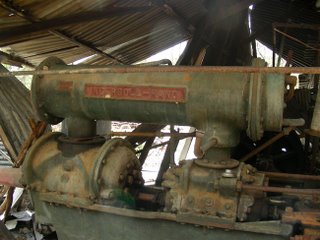
Up over the hill loomed the grey dumps of the Deep Lead, until recent years one of the great alluvial tin-fields of Australia. A rumbling of thunder came from away back in the hills around Herberton where the reef miners were blasting the rock in their ceaseless search for tinstone. Enviously I wondered whether the shots were fired by the lucky Bimrose brothers, whether the murmurous thunder came from the Bradlaugh, the Lyee Moon, the Rainbow or Great Northern. Maybe the St Patrick or Black King—I'd hardly hear it from the Ironclad. Some of the big shows had struck rich patches of ore; how wonderful it must feel to be blasting out a rich crushing, with everyone in town wondering what percentage the stone would go! I could not imagine anything more wonderful. Just what could that heavy, dull, greyish-black stone mean to a man!
Ion Idriess
 At the turn of the 19th century, Herberton was a town of tin miners and publicans. A hundred years later, the mines have closed and Herberton is more sedate. The story repeats along the western edge of the Atherton Tablelands: they came, they mined, they cut loose and then they left.
At the turn of the 19th century, Herberton was a town of tin miners and publicans. A hundred years later, the mines have closed and Herberton is more sedate. The story repeats along the western edge of the Atherton Tablelands: they came, they mined, they cut loose and then they left.Herberton is a short detour from the tourist route. It lies about 15 kilometres SSW of Atherton on a road that meanders pleasantly through state forest. The town straddles Wild River, where a quartet of prospectors discovered a tin lode in April 1880. They reported that the assays revealed 71% tin from the lode and even higher levels from alluvial (stream) deposits.
 Within a couple of months, the Improvement Committee at Port Douglas commissioned Christie Palmerston to find a route to Wild River. His fee was £20. Palmerston, who had already carved out a track to the Hodgkinson goldfield, found a suitable road through the mountains. By August of that year, seventy miners had excavated over 100 tons of tin.
Within a couple of months, the Improvement Committee at Port Douglas commissioned Christie Palmerston to find a route to Wild River. His fee was £20. Palmerston, who had already carved out a track to the Hodgkinson goldfield, found a suitable road through the mountains. By August of that year, seventy miners had excavated over 100 tons of tin.Herberton had hit the big time.
 The road was good in the dry season but became impassable in the wet. After a near disaster in 1882, when supplies did not reach the town for months, the miners lobbied for a railway. While blasting along the bank of the Wild River, the over-enthusiastic engineers blew the Presbyterian Church from its stumps. (It's not known whether that was really an accident ...) The track took almost thirty years to complete. The first train pulled into Herberton Station on 20th October 1910. The last one pulled out in 1989.
The road was good in the dry season but became impassable in the wet. After a near disaster in 1882, when supplies did not reach the town for months, the miners lobbied for a railway. While blasting along the bank of the Wild River, the over-enthusiastic engineers blew the Presbyterian Church from its stumps. (It's not known whether that was really an accident ...) The track took almost thirty years to complete. The first train pulled into Herberton Station on 20th October 1910. The last one pulled out in 1989.As you drive down the main street of Herberton today, it's difficult to imagine that less than 120 years ago it hosted the richest horserace outside Brisbane with a purse of £4000. Serious money. The town was the site of many firsts on the Tablelands. It boasted the first citrus orchard, first winery, first golf course, first race course, first dairy farm and the first brewery.
 The Shire Council runs the Mining Centre on the site of the Great Northern Mine. The Centre is a local museum dedicated to the tin mining history of the area. It's a typical small museum—underfunded, underconserved but packed with fascinating material. A lucky dip of artefacts. I spent two hours there, which might have been the longest time anyone had stayed. But I was captivated by the history of the area and by the characters who had made the town their home over the past century or so. You'll hear all about them. Don't you worry about that!
The Shire Council runs the Mining Centre on the site of the Great Northern Mine. The Centre is a local museum dedicated to the tin mining history of the area. It's a typical small museum—underfunded, underconserved but packed with fascinating material. A lucky dip of artefacts. I spent two hours there, which might have been the longest time anyone had stayed. But I was captivated by the history of the area and by the characters who had made the town their home over the past century or so. You'll hear all about them. Don't you worry about that!